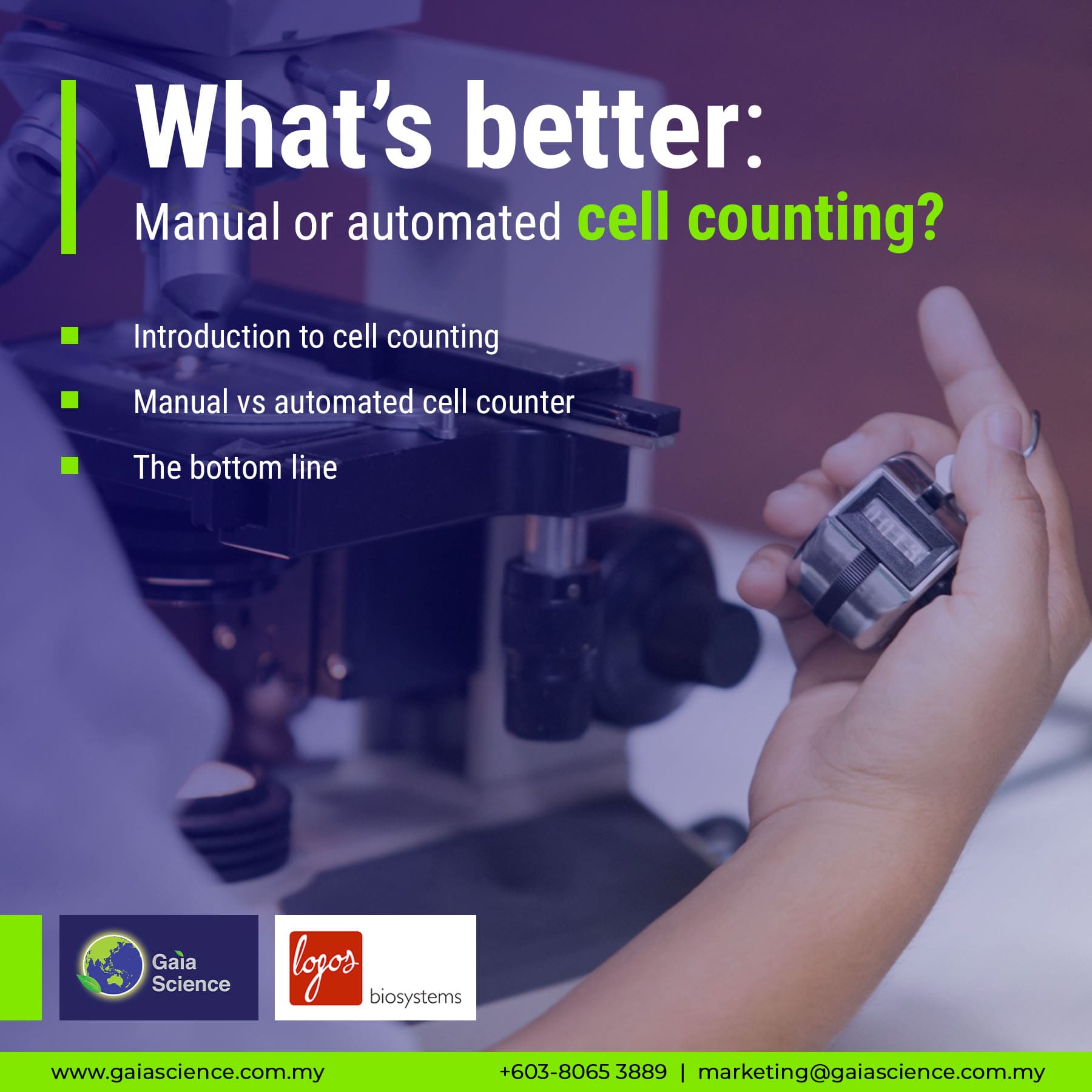News & Events - Details
What’s Better: Manual or Automated Cell Counting?
20 June 2022Cell counting is a procedure with a choice of numerous diverse techniques, most of which rely on specialized laboratory appliances. The practice usually involves directly counting individual cells in a small volume in order to get an estimate of how many cells are in a larger volume. This can be useful for culture maintenance, setting up assays, assessing the health or viability of cells in a culture, and clinical or diagnostic applications. But when should you take your cell counting to the next level by getting a machine to do it for you?
Despite the variety of cell counters available for modern-day life science applications, they can typically be divided into one of two sub-groups: manual and automated cell counters.
Manual cell counting
|
The conventional method of cell counting is done manually at a benchtop microscope using a special type of slide with a grid known as a hemocytometer. The slide contains a chamber with an etched grid on the lower surface. This device was originally developed for blood sample analysis but is now widely utilized for cell counting and viability analysis for a broad range of mammalian cells. Manual cell counting can be performed with or without stains. For viability assessment, an exclusion dye such as trypan blue is commonly used. Cells are mixed with the dye and incubated before being pipetted into the measurement chamber. Once the sample has filled the counting chamber by capillary action, cells can be directly observed using a microscope and counted in specific sectors on the grid. Although it is widely adopted as a method, trypan blue has many well-documented limitations for assessing cell viability. Trypan blue is used to count dead cells; the dye is excluded from cells with intact membranes so only dead cells are stained blue. The process is imperfect and cell color is often difficult to interpret. Consequently, this process is highly subjective. It is also toxic to cells causing changes in viability not related to the health of the sample. The benefits of manual cell counters are the low initial purchase price and ongoing operating costs, especially when considering the significant cost-increase when it comes to using automated cytometers with single-use plastic slides. The main drawbacks to manual cell counting are:
|
|
Automated Cell Counters
Existing automated cell counters have the advantage of largely removing human subjectivity from the cell counting workflow. They are also often faster than counting manually and can count a larger number of cells, increasing statistical accuracy.
Automated systems generally rely on either an imaging-based approach or an impedance-based approach. Imaging-based systems use a microscope and camera that will capture an image and then use an algorithm to count the cells. Meanwhile, impedance-based systems measure electrical resistance to determine the number of cells.
Cell counters that use the image-based approach can further be divided into either fluorescent or brightfield imaging. Brightfield imaging is widely used in cell culture labs for selectively staining dead cells and tissues. The use of brightfield imaging can present challenges for accurately assessing cell counts and viability in some sample types. For these samples, a fluorescence assay such as Acridine Orange / Propidium Iodide (AO/PI) is a simple and highly accurate alternative.
Manual vs. automated cell counting
The main considerations between manual and automated cell counting are cost, labor, and accuracy.
The low initial purchase price of a hemocytometer compared with a cell counter is attractive to many experimentalists on a limited budget; however, one must also consider the ongoing costs of the additional labor required and the ultimate price of inaccurate results over the life of the instrument. Cell counters provide additional advantages beyond time and labor savings and increased accuracy, enabling cell biology researchers to conduct experiments using previously unavailable methods.
|
|
Believe it or not, all cell counters are not created equally. Ask a colleague with a handheld counter that sits in a drawer or a bench-top cell counter and they will tell you that some cell counters don’t work as expected! With a variety of cell counting methodologies available, not to mention a bewildering array of instruments, selecting an automated cell counter to meet the exacting requirements of your busy laboratory can be challenging. There are several automated cell counters on the market. But do you know what to look for in those systems? Watch this on-demand webinar [Ultimate Guide to Automated Cell Counting] to find out more.
|
|
The bottom line
Since the operator directly observes the cells, manual counting still has a few important strengths, such as early problem detection, allowing the user to capture any errors quickly. Nevertheless, with all the new features, improved technology and software, automated cell counters have become an essential technology for many researchers. The compatibility of automated cell counters has been verified for use with several commonly used cell lines and primary cell types. Focusing on details of both manual and automated systems regarding their costs, accuracy, versatility, and reporting and how these are related to your requirements will help to decide whether it is time to move on and automate cell counting in your lab.
A final tip
When trying a new setup, always try to arrange a demonstration. With a trial, you can see if the product fits your needs.
Visit our website to learn more about our solutions for cell counter https://lnkd.in/gAS-Hc38 and request for a demo today.


 SingaporeSG
SingaporeSG ChinaCN
ChinaCN MalaysiaMY
MalaysiaMY IndonesiaID
IndonesiaID MyanmarMM
MyanmarMM

